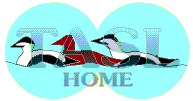
last updated: 1/25/98
url: http://www.gis.net/~szendeh/troost.htm

Over the years we've all spent a lot of Sunday mornings looking at the waterfowl in Boston Harbor, counting the ducks at various locations as they go about their feeding, preening and other daily activities, but have you ever wondered where these same ducks spend the night? Well, I had not until I moved to a house near Dorchester Bay, along Carson Beach in South Boston.
Carson Beach is along Day Boulevard in South Boston (near the Bayside Expo Center); there are parking lots on either side of a very long brick building. From the lots, without leaving your car, you can observe waterfowl and gulls, with the occasional odd one: Black-headed, Iceland or Glaucous. And in autumn there are plenty of peeps, plovers and other shorebirds that sometimes frequent Columbia Park (across the street) during heavy rains and high tides.
Late one November afternoon several years ago I was walking along this beach and was surprised to see a raft of ducks that at a glance certainly appeared to number over one thousand. I had driven by here hundreds of times before and had usually seen a handful to perhaps as many as 50 ducks during the day, but nothing like this large tight group. I have loosely monitored this occurrence for several winters. Although no firm conclusions can be drawn from this experience it is nonetheless interesting to observe.
From November until April, from about 3:30 to 4:30 in the afternoon, large numbers of three species, Common Goldeneye, Red-breasted Merganser and Bufflehead, fly in from around the harbor to roost. You can stand there on a good afternoon and watch the ducks fly in until it is dark. Indeed they are still flying in when you realize it is too dark to identify them; are those females goldeneyes or mergansers? Depending on wind and tides the birds will sometimes be far out (150 yards or more), sometimes much closer. Further out are also scoters (between 200 and 450 this year--unusually high) which are impossible to tell apart. It is extremely difficult at dusk to get an accurate count of the three main species (interspersed with 25 to 80 Horned Grebes) usually in a tight bunch swirling around each other.
As long as the bay remains unfrozen this is a nightly occurrence with six or seven hundred birds minimum to about 3,000 birds maximum. On several dates I have estimated numbers of 2,200, 2,500 and 3,000, although 1,200-1,800 is probably the norm. Except for the unusual presence of White-winged and some Surf Scoters the three main species make up at least 90% of the birds that roost here. Eider are almost never seen, though Brant (up to 280) fly over from Squantum but stay apart from the other birds. Large groups of scaup used to appear, but no longer. The only other winter water birds here are a few American Black Ducks, an occasional Red-throated Loon, and lots of gulls. This winter for the first time my brother Steven and I saw a Barrow's Goldeneye mixed in with the flock. I've seen it on several occasions.
When you watch the goldeneyes fly in, often up to a thousand individuals, you would think that every goldeneye in Boston Harbor must spend the night here; in most years you would say the same of the mergansers (frequently numbering between 1,000 and 1,500, though they are scarcer this year) and of Buffleheads. These numbers can fluctuate from month to month. Carson Beach is well protected from waves and strong winds. I guess this is why they seek the shelter of this bay. It raises a few questions; how do they get together everyday, every winter in this same place from all over the harbor? Is there some safety in numbers? Safety from what?
It would be interesting to take TASL and Boston Christmas Count totals of the three main species and see how they compare with the totals at Carson Beach. The conditions, however, make it hard to be accurate: The birds are very concentrated, swimming around, and the light gets poor rapidly. In any case, if anyone else knows of a similar roost anywhere around the harbor I would be very interested to hear of it, especially to see how these totals correspond to the TASL totals.
It is amazing to see more ducks in a five minute period than I see during several hours of TASLing. It is a strange experience to see this big concentration of ducks with the harbor and islands behind them, and behind me the silhouette of the city and the setting sun, sort of half urban, half wild.
Ronnie Donovan
TASL News 2/95

last updated: 1/25/98
url: http://www.gis.net/~szendeh/troost.htm